MacGregor 26... Factory website for the MacGregor 26', $15,990 trailerable sailboat, 24 mph, the WORLD'S best selling cruising sailboat.
HOW TO SAIL: BY ROGER MACGREGOR
RETURN TO THE MACGREGOR WEB SITE TABLE OF CONTENTS
THE MOST IMPORTANT THING YOU MUST KNOW IS THE DIRECTION FROM WHICH THE WIND IS BLOWING. Program someone to ask you, every 2 minutes "where is the wind coming from?" You must point to it instantly, and be right. Put a Windex wind vane at the top of the mast, and keep your eye on it. If you donít know wind direction, you will look sort of stupid when trying to use the wind as your engine. There are clues everywhere; flags, smoke, dust, moving clouds, ripples on the water, other sailboats, and blowing debris. Above all, you can feel the wind direction on your face. Turn toward the wind. When you are aimed straight at it, you will feel it evenly on both ears, cheeks, hair, etc. Be aware.
SAILING DOWNWIND. Sailing with the wind is easy. Just aim the boat and the wind will blow you along. A boat sailing downwind looks like this.
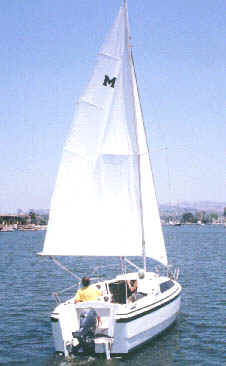
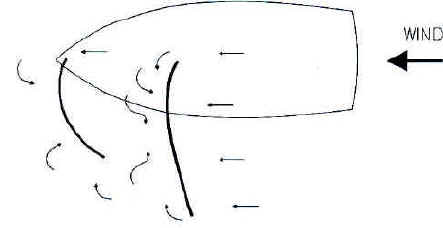
Sailing downwind
This is no more complex than letting a balloon blow with the wind. (Except that you can steer.) You can sail downwind, slowly, without sails. (This is good for docking.)
Just get the sails out there at right angles to the wind. You control the angle of the sails to the wind with the sheets (the lines that connect to the rear of the jib and to the rear of the boom). The wind pushes on the sails, and the boat moves. Notice the turbulence behind the sails, just like the turbulence behind a truck as it speeds along. If the wind gets on the wrong side of the mainsail, it can slam over fast and hard, just like the wind will slam a door if it gets on the wrong side. This is called jibing. Be careful. More on this later.
SAILING ACROSS THE WIND. This is a whole different act. Notice, in the next set of drawings and photos, that the wind is now flowing smoothly across the sails, much like the wind moves across the wing of an airliner.
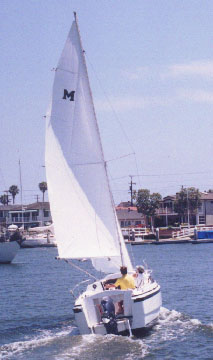
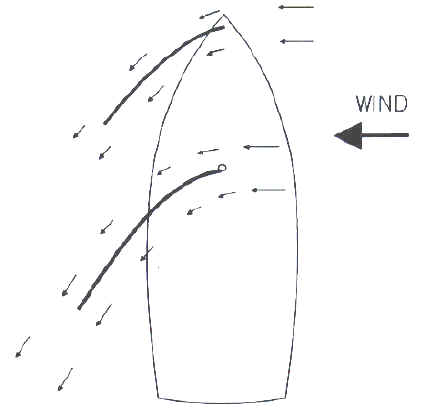
Sailing across the wind
Basically, the sails are diverting wind from its original direction toward the rear of the boat. Every pound of wind that is deflected toward the rear of the boat gives a forward push to the boat. Actually, the wind gives a push both forward and sideways (making the boat lean). However, the rudder and the centerboard keep the boat from sliding sideways, so it squirts forward, much like a watermelon seed shoots out forward when you squeeze it between your fingers.
SAILING INTO THE WIND. This is just like sailing across the wind, except that the sails are pulled in closer to the centerline of the boat, and you are now trying to sail as close into the wind as you can. This is tougher to do, and the boat wonít go as fast as when sailing across the wind. The following drawing shows the boat sailing toward the wind. This is as close into wind as you are going to get.

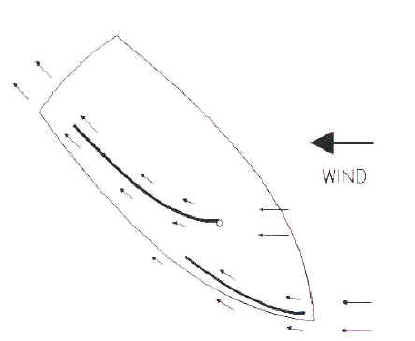
Sailing into the wind
Notice the smooth wind flow across the sails, and the lack of turbulence. Wind is being properly diverted toward the rear of the boat, and like the blast of air coming out of the rear of a jet, pushing the boat forward and sideways. More of the force is now sideways, so the boat will tend to lean more, but it will still squirt forward, since the centerboard is keeping it from going sideways.
You can't sail straight into the wind. The sails will flap like flags, divert no wind, and you will just sit there, frustrated, dead in the water. This is being "in irons".

Trying to sail , unsuccessfully, straight into the wind.
So how do you get to point A in the above drawing if you canít sail directly toward it. You zig zag, (tack) like this.

Zig zagging (tacking) into the wind
THE FIRST DAY OUT. Launch the boat on a nice day with a light breeze. There should be just enough wind to move the boat around. (You have to be moving if you expect the rudder to work.) Fill the ballast tank. Make sure the rudders and centerboard are all the way down. Start the engine. Power slowly out to the middle of a calm body of water, where there is nothing to bump into, point into the wind, and put up the mainsail. Keep the engine running slowly, moving the boat about 2 mph. With the engine running and moving the boat forward, try to duplicate what you see in the above diagrams. Sail with the wind, across the wind and as close into the wind as you can go. Blunder around like this for a while, trying to match the angle of the boom to the wind as you see in the diagrams. After a half hour or so of this, you will get a good feel of what works and what doesnít. If you screw up, or the sails shove the boat in a direction that you donít wish to go, overpower the sails with the engine. Use reverse if you have to stop. In a tug of war between the engine and the sails in moderate winds, the engine will win.
Then raise the jib. Remember that the jib control line is pulled in on the side of the boat away from the wind. The line going to the other side is left loose. As you zig zag into the wind (tacking), you will have to release the jib line (sheet) from one side and pull it in on the other. The mainsail control line (mainsheet) takes care of itself. You donít have to reset it each time you turn through the direction from which the wind is blowing.
STOPPING THE BOAT. If you are sailing, with the engine off, you can always stop the boat by turning into the wind and letting go of the jib control line and the mainsail control line. When you do this, the wind pressure is off of the sails, the boat will coast a few more boat lengths and come to rest. This also is good for docking when the dock is upwind. A motor is better.
HOW DO YOU KNOW IF THE SAILS ARE SET AT THE PROPER ANGLE TO THE WIND. There are some simple tricks that are used by the experts. When sailing in the same direction as the wind (called "running"), just let the sails out until they are at right angles to the wind. You are trying to catch as much wind as possible. Unfortunately, the mainsail blocks the wind from hitting the jib, so the jib will just hang, unless you can hold it out on the opposite side of the mainsail, as shown below. This adds sail area, but it only works when the wind is coming from directly behind the boat.
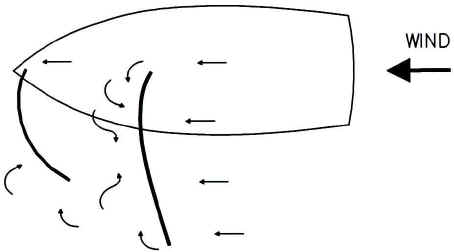
Sailing downwind with the jib buried behind the mainsail
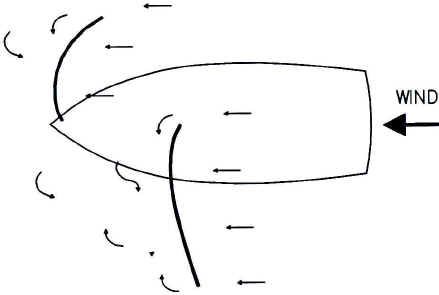
Sailing Downwind with jib out
When sailing at right angles to the wind (called "reaching"), pull in the mainsail control line (mainsheet) and the jib control line (jibsheet) until the wind completely fills the sails.
If the sails are not pulled in far enough, the fabric near the leading edge will flutter and ripple. This is the result of the wind hitting the sail on the wrong side and forcing the fabric toward the upwind side. This fluttering (often called "luffing") is shown in the following drawing.
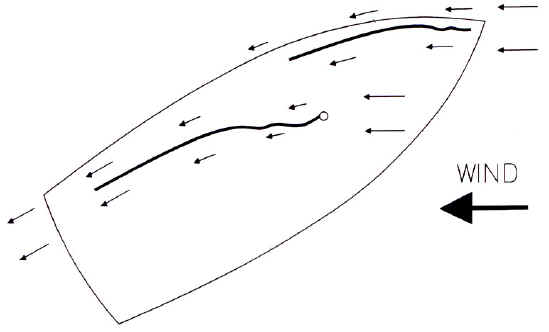
Sails not pulled in enough (Luffing)
Keep pulling the mainsheet in until the fluttering just disappears, and the sail forms a smooth curve from the mast to the rear edge. Unfortunately, the sail will not tell you if it is pulled in too far; it will still look smooth and full, but will not move the boat well. Let the mainsheet out until the fluttering and bubble reappear along the mast. Then pull the sail in until the fluttering and bubble just disappear. This is now the perfect sail setting. Because the wind is always changing, you have to keep making this test for top performance.
There is another neat trick to let you know when the mainsail is pulled in too far. Secure a 7" long piece of yarn near the rear end of every batten pocket. Use a large needle to push the yarn through the sail.
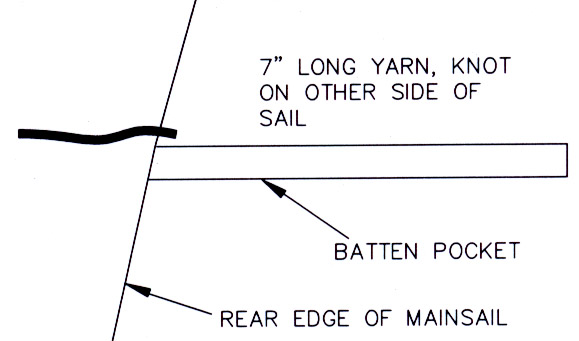
Mainsail streamer
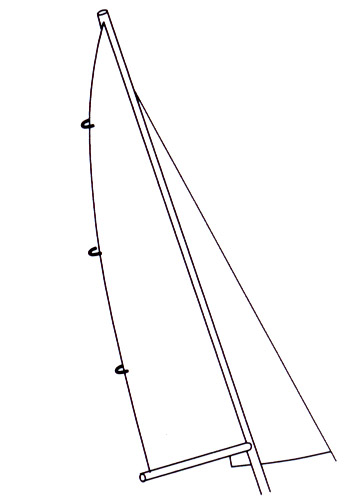
Streamers curling. Not good
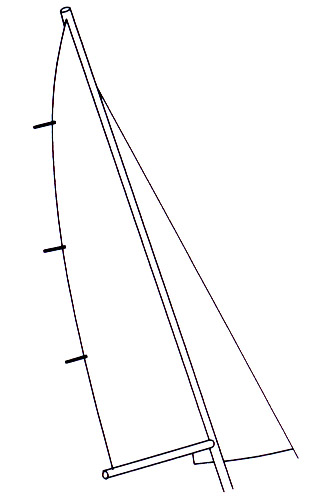
Streamers straight. Good
If they curl, gently let out the mainsail until they stream out straight and not try to hide behind the sail. The yarns tell when the sail is in too tight (which really slows up the boat and causes it to lean over more), but they do nothing to tell you when the sail is let out too far.
Even if you point the boat straight into the wind and the sail is doing an impersonation of a flapping flag, the yarns will stream nicely to the rear. You have to watch for the fluttering and ballooning to appear at the front edge of the mainsail. Pull it in until the fluttering disappears. So, the fluttering tells you if it is out too far, and the yarns tell you if it is in too far.
Trimming the jib is just about the same as trimming the mainsail. The jib, however, comes with built in streamers (called "tell tales") to make it easy. The streamers are about 12" in from the front edge of the sail. There are 2 sets, evenly spaced up the sail.
When the sail is pulled in just right, all of the streamers, on both the upwind and downwind sides of the sail, will be flowing straight to the rear.
When the streamers on the downwind side are going around in circles and not flowing to the rear, the jib is pulled in too tight. The wind cannot make the sharp turn around the front edge of the sail, and the streamers are caught up in the resulting turbulence. Let out the sail.
If the streamers on the windward side of the sail are dancing around and not flowing to the rear, the sail is not pulled in tight enough. Always trim the jib first, then the mainsail, since the flow off the jib affects the mainsail trim.
You always have two ways to get the angle of the sails to the wind just exactly right. You can pull the ropes to change the sail angle, or you can keep ropes as they are and steer in a new direction. The latter is easier on the arms, but you may not get where you want to go, but you will be going a lot faster.
When you are sailing as close as possible into the wind, secure the sails and adjust the angle of the sails to the wind by steering the boat into or away from the wind.
When sailing across the wind or into the wind, try to sail a constant leaning (heeling) angle. If it leans to much, sail into the direction from which the wind is blowing (called "heading up"), relieving some pressure on the sails. If the boat starts to stand up straighter, steer away from the wind direction (called "heading down"). The wind will hit the sails at more of an angle and cause the boat to lean more, and you will get more power. This helps to keep the sails at the proper angle to the wind. A leaning (heeling) angle should look about like this when going into the wind in an 8 mph wind.
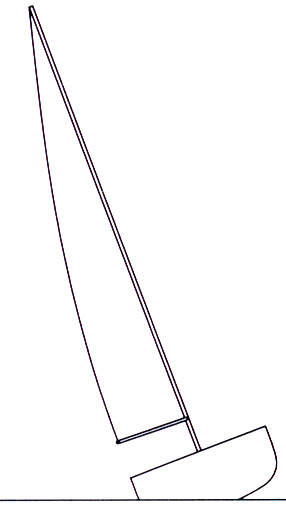
Proper leaning angle in 8 mph wind
APPARENT WIND. This is tricky, but important. The wind that the boat feels is actually two winds. The first is the wind that moves across the water, that creates the waves and makes flags stream downwind. (This is called the true wind). The second wind is the wind produced by the speed of the boat. If there is no true wind, and your outboard pushes the boat at 5 mph, you and the boat will feel a 5 mph wind coming right at the front of the boat. (This is called the apparent wind).
If there is a 10 mph true wind, and the boat is going straight into it at 5 mph, you and the boat will feel a 15 mph apparent wind from straight ahead.
If there is a 10 mph true wind, and the boat is going with the wind (downwind) 5 mph through the water, you and the boat will feel a 5 mph wind at your back.
If there is a 10 mph true wind, and you are powering at right angles to the wind at 5 mph, the situation is more complicated. The wind the boat feels will be a combination of the two winds; the true wind from the side and the wind created by the motor from straight ahead. The apparent wind will appear to come from about 60 degrees from the side of the boat. It takes trigonometry to calculate the exact apparent wind speed and direction. Looking at the wind vane is easier.
The sailboat has only a small brain, and only feels the apparent wind, and this is what it must sail in. The apparent wind will determine how the sails are to be trimmed, and how the masthead wind indicator will point. It is the wind you must use to sail. But the complexity gets worse. As the speed of the boat changes, and as the true wind speed gusts and eases, the apparent wind strength and direction will change, and you have to keep trimming the sails or altering course as the changes occur. You donít have to, of course, you can just get it close enough to enjoy the ride. But if you want to sail like a superstar, you will have to keep tweaking and adjusting for perfect trim all the time. This wins races. (You can learn to sail quite well in a matter of hours. But it will take a lifetime to master all of the subtle little intricacies.)
Another complexity. As you pick up speed, the wind from the front of the boat increases, and the apparent wind will come more from the front of the boat. Actually, the apparent wind will now be stronger than the true wind, so you have more usable wind to sail in. With each new change in wind speed or boat speed, you will need a new sail trim.
When you watch the tell tales on the jib and the streamers at the rear of the mainsail, you will notice that the top ones donít always flow in the same manner as the lower ones. This means that the sail is not at the same angle to the wind at various heights. Wind blows harder as you go higher, and there will be a different apparent wind (and wind angle) up there. (This is because the friction of the earth and water slows wind down at low levels.) You may see the upper mainsail streamers trying to hide behind the mainsail, and the lower ones flowing nicely to the rear. This means that the top of the sail is in too tight. The boom vang controls this. Loosen the vang, and watch the upper part of the sail sag outward away from the wind. Tighten the vang, and it pulls down on the boom and pulls in on the upper part of the sail. When the vang is set right, all the streamers will behave the same. Fortunately, sailcloth is a bit stretchy, and the top will usually sag off just about enough to match the angle change caused by stronger winds higher up.
The jib has no boom, therefore there is no vang. But you can use the position of the jib sheet pulley on the deck track to control twist. If you move the sliding pulley forward on the track, the top part of the sail will be pulled in tighter. Move it to the rear, and the top part sags off downwind. Move the jib pulley on the track so that all of the telltales flow the same. If the top one on the upwind side flutters before the bottom one, move the pulley forward. If the bottom one is the first to flutter, move the pulley to the rear.
When sailing upwind you can also tell how you are doing by watching the forward edge of the jib. As you point the boat up into the wind, the leading edges of the jib will start to flutter and collapse inward. Turn away from the wind until the fluttering at the front part of the sail stops and the sail appears full. Try to steer the boat so that the front of the jib is just on the edge of starting to flutter and collapse. You will notice that the tell tales start flopping around just as the sail starts to flutter in front of the tell tales. The tell tales and the fluttering are both giving you the same message.
The jib halyard must be very tight, or the sail will sag between the snaps on the forestay. This is a most common problem for beginners. The mainsail halyard should be tight, but not so tight as to create vertical wrinkles at the leading edge of the sail, parallel the mast.
The outhaul, mainsail halyard and jib halyard should be tighter in heavy air to flatten the sails, an loosened in lighter wind. In general, you want a very flat sail in heavy wind, to kill off some of its power, and very full and baggy sail in light wind, when you need all the power you can get. The fuller the sail (baggier) the more the power.
There are light lines sewn into the rear edge of each sail. Adjust these lines just tight enough to keep the rear edge of the sail from fluttering. If you get the lines too tight, the rear edge of the sail will cup toward the wind and slow the boat up a small amount.
The time to reduce sail area is when you first think that it might be necessary. Even with less sail, the boat will be faster if the heeling angle can be kept below 25 degrees. Beyond that, performance goes all to hell.
The reefing sequence goes like this:
1. If you canít keep the leaning angle below 25 degrees, flatten the mainsail with halyard and outhaul. Flatten the jib or genoa by tightening the halyard. Loosen the vang to allow the top of the mainsail to twist downwind and spill wind. Move the jib deck pulley to the rear of the track to let wind spill out of the top of the jib.
2. If you still canít stand up straighter than 25 degrees, roll the genoa about 1/2 way in. If you donít have roller furling, change from genoa to jib.
3. After that, put a reef in the main, and keep the partially rolled genoa or the full jib.
4. If it still leans too much, roll away more genoa, (or get rid of the jib) and keep the reef in the mainsail.
5. If that isnít enough, consider pulling down the sails and powering home. Or pull down all of the sails and ride it out until the wind lets up. If you are sailing downwind, you can use just the jib or reefed genoa. (This doesnít work well upwind.)
When sailing into the wind, try leading the genoa sheet between the upper shroud and the lower shroud. This will allow the boat to point 5 to 7 degrees closer into the wind.
When racing in heavy wind, have at least a 4 man crew. In light air, the fewer the better. Remember it is against the rules to throw crew members overboard to lighten the boat.
The boats bottom, rudders and centerboard must be clean and shiny. A few days of marine growth will slow the boat dramatically. Any bumps at all, even microscopic, will create turbulence and destroy the orderly flow of water across the surface, and really screw up performance.
Keep the boat moving. With the small centerboard, forward speed is essential to keep the board lifting the boat into the wind. No speed, no lift, and the boat will just slide sideways.
Be sure to get rid of all extra weight. Crew can be moved to the windward side to keep the boat level. Junk in the boat is hard to move, and it will just slow the boat down. Light weight is very important downwind. Going upwind, added weight can sometimes be helpful. Waves and chop tend to slow up a light boat, while a heavier boat can plunge right on through. Keep rudder motion to a minimum. Steering creates lift from side to side. Lift is always accompanied by drag. Keep the rudder angle steady.
When trimmed properly, the boat should want to head up into the wind when you let go of the wheel. When sailing into the wind, the front of the rudders should be turned about 5 degrees toward the upwind side of the boat.
When sailing with the wind, avoid sailing straight downwind. Point up into the wind about 20 degrees, until the jib is not smothered by the mainsail, and starts to work. If your destination is straight downwind, tack back and forth as shown below. The boat will go a lot faster, which will more than make up for the fact that you have to sail a bit farther.

Tacking downwind
This will also reduce the risk of accidentally jibing. When you do want to jibe, pull in the mainsheet until the boom is near the centerline of the boat, and gradually let it out on the other side. Donít let it slam over hard. Keep the crew off the cabin top if there is risk of jibing. The boom can whack them.
When sailing, make sure the ballast tank is full. When under sail in heavy winds, keep the crew weight aft and to the windward side. In light wind, keep the crew forward and positioned so the transom is almost out of the water and the boat heels about 5 to 10 degrees. This heeling reduces the amount of hull surface in contact with the water. In light wind, the surface area touching the water creates most of the drag. The more surface in contact with the water, the slower the boat will go. A 10 degree angle of heel reduces this area significantly.
It has been said that the art of seamanship is not getting yourself in a position where you need seamanship. Always be careful.
RETURN TO THE MACGREGOR WEB SITE TABLE OF CONTENTS